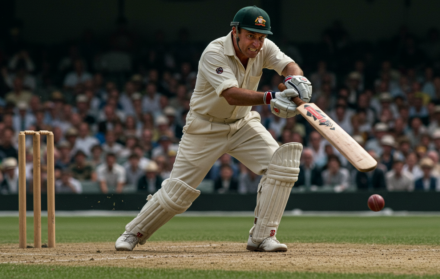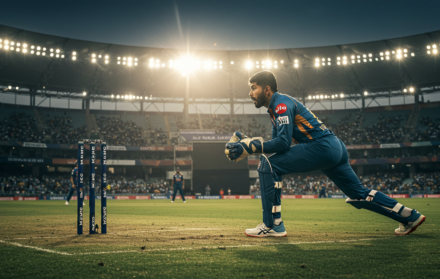
What Is A Wicket In Cricket
Cricket, a popular sport played in many countries around the world, has its own unique terminology and rules. One essential element of cricket is the “wicket.” But what exactly is a wicket in cricket?
A wicket in cricket refers to three wooden stumps and two bails balanced on top of the stumps. It is the target that the bowler aims to hit in order to dismiss the batsman.
When the ball hits the stumps and dislodges the bails, the batsman is considered “out.” A wicket can also refer to the area between the stumps, where the batsman stands and defends against the bowler.
Taking wickets is of utmost importance in cricket as it directly affects the outcome of the game. By dismissing opposing batsmen, the bowling team gains an advantage, and it becomes challenging for the batting team to accumulate runs.
Understanding the concept of a wicket and its role in cricket is essential for both players and fans of the sport.
Components of a Wicket
When it comes to cricket, understanding the components of a wicket is crucial. In this section, we’ll dive into the building blocks that make up a wicket.
Get ready to explore the ins and outs of stumps and bails – two essential elements that play a pivotal role in the game.
From their dimensions to their significance, we’ll unravel the fascinating details that give a wicket its dynamic nature. So, let’s delve into the world of cricket’s core components and unlock the secrets of the wicket.
Stumps
Stumps are the most important component of a cricket wicket. They consist of three wooden poles or stakes that are driven into the ground, with two bails resting on top. Here are some key points about stumps:
- Stumps are made of wood, usually ash, and are approximately 28 inches tall and 9 inches wide.
- They are painted white to contrast with the pitch and make them more visible to the players and umpires.
- The stumps must be placed in line with the boundary of the pitch, with the middle stump exactly in the center.
- If any part of the stumps is knocked over or dislodged by a bowler, the batsman is considered out.
- The bails, which sit on top of the stumps, are small wooden pieces that must be dislodged for a wicket to be taken.
In a thrilling cricket match, the bowler delivered a fast-paced ball, hitting the off-stump and sending the bails flying. The batsman, shocked by the accuracy of the delivery, had to make his way back to the pavilion, leaving the team and the crowd in awe of the bowler’s skill.
Bails
The bails, which are two small wooden pieces that sit on top of the stumps, are crucial components of a cricket wicket. It is important that the bails are balanced and not easily dislodged by the wind or light contact. While wooden bails are generally used, there are also synthetic options available.
The bails play a significant role in determining if a batsman is out, and they bring excitement to the game when they fly off after a delivery.
Historically introduced in the early 19th century, bails provide a clear indication of when a wicket has been broken.
They have become an integral part of the game, witnessing various improvements to ensure fairness and accuracy in decision-making. The design and materials of the bails have evolved to meet the demands of modern cricket.
How Does a Batsman Get Out through a Wicket?
When it comes to the game of cricket, one of the key aspects that keeps the excitement alive is how a batsman can be dismissed through a wicket.
Whether it’s being caught, bowled, or even getting out through an LBW, there are various ways the batsman’s innings can come to an end.
In this section, we’ll explore the different methods of dismissal including being stumped, run out, or even the rare occurrence of hitting the wicket. So, get ready to uncover the thrilling ways a batsman can make an exit in cricket!
Bowled
To get a batsman “bowled out” in cricket, the bowler must hit the wicket and dislodge at least one bail. This is one of the most common ways to get a batsman out. Here are some key points to understand about being bowled:
- To be considered bowled, the ball must hit the wicket, which is composed of three stumps and two bails.
- The bails are small wooden pieces that rest on top of the stumps.
- If the ball hits the stumps with enough force to dislodge at least one bail, the batsman is considered “bowled out.”
- Being bowled is often a result of the batter missing the ball completely or failing to defend their wicket.
- Bowled is one of six ways a batsman can be out in cricket, along with caught, LBW (leg before wicket), stumped, run out, and hit wicket.
When playing or watching cricket, it is crucial to understand the different ways a batsman can be dismissed. Knowing the rules will enhance your enjoyment and appreciation of the game.
Caught
Getting caught in cricket refers to when a batsman strikes the ball with their bat, and a fielder catches it without it touching the ground.
If the ball bounces before being caught, it does not count as a catch. Multiple players, including fielders, wicketkeepers, or even the bowler, can make the catch.
Fact: Rahul Dravid, the former Indian cricketer, holds the record for the most catches by a fielder in international cricket, with 210 catches in Test matches.
LBW
To gain a better comprehension of LBW (Leg Before Wicket) in cricket, take into account the following:
- Definition: LBW is a method for a batsman to be dismissed in cricket when the ball hits their leg in front of the wicket while attempting a stroke.
- Conditions: To be given out LBW, the ball must have pitched in line with the stumps, struck the batsman’s leg in front of the stumps, and have been heading towards the stumps.
- Umpire’s Decision: The decision to give a batsman out LBW is determined by the on-field umpire, or it can be reviewed by the fielding team using the Decision Review System (DRS).
Understanding the LBW rule is crucial for both players and spectators of the game, as it significantly impacts the outcome of a match.
Stumped
In cricket, getting stumped is a way for the fielding team to dismiss a batsman. Here are the key points to understand about being stumped:
In cricket, a wicket is a way for the fielding team to dismiss a batsman. Here are the key points to understand about being stumped:
- Definition: Stumping occurs when the wicketkeeper removes the bails while the batsman is outside their crease and not attempting a run.
- Requirements: The bowler must deliver a legitimate ball, and the batsman must miss it or step out of their crease to play it.
- Action: The wicketkeeper catches the ball and quickly removes the bails, leaving the batsman “stumped” and out of play.
- Strategy: Wicketkeepers often try to distract batsmen by standing close to the stumps, giving them less time to react and stay in their crease.
- Effect: Stumping is an effective way to dismiss a batsman, as it requires quick reflexes and good coordination between the bowler and wicketkeeper.
Run Out
When it comes to cricket, a “run out” is a way for a batsman to be dismissed. This occurs when the fielding team successfully gets the ball to the wicket while the batsman is running between the wickets. Here are the steps involved in a run out:
- The fielder retrieves the ball quickly.
- They aim for the stumps and throw the ball accurately.
- The wicketkeeper receives the ball and breaks the stumps with the ball or in some cases, their hand.
- If the batsman hasn’t reached the crease or crossed the line, they are considered “run out” and dismissed.
Pro-tip: To increase the chances of a successful run out, fielders need to communicate well and be aware of each other’s positions. Practice coordination and accuracy to execute a run out effectively.
Hit Wicket
When a batsman accidentally hits his own wicket with the bat or any part of his body while attempting to play a shot, it is referred to as “hit wicket“ in the game of cricket.
This particular mode of dismissal occurs when the batsman loses control or balance, leading to their declaration as out.
Although it is not a common occurrence, batsmen must remain mindful of their movements and maintain control to avoid getting out in this unconventional manner.
Pro-tip: Batsmen need to be cautious of their actions and ensure proper control to prevent being dismissed through this unusual means.
The Role of the Wicketkeeper
The role of the Wicketkeeper is of utmost importance in the game of cricket. They possess the unique privilege of wearing gloves and donning pads to safeguard themselves while stationed behind the wicket.
Their chief responsibility lies in safeguarding the team’s interests by catching the ball when the batsman fails to connect, or when the bowler successfully claims a wicket.
Moreover, they exhibit exceptional agility and swiftness in order to stump the batsman by dislodging the bails from the wicket when the batsman ventures beyond the crease.
The wicketkeeper is an indispensable component of the fielding unit and their contribution significantly contributes to the team’s triumph.
The Importance of Taking Wickets in Cricket

Taking wickets in cricket is of utmost importance as it directly impacts the outcome of the game. Here are some reasons why taking wickets is essential:
1. Breaking partnerships: When a team takes a wicket, it not only removes a batsman but also breaks their partnership, disrupting the flow of runs and putting pressure on the opposition.
2. Building momentum: Taking wickets provides a boost of confidence for the fielding team, which can lead to increased morale and energy on the field.
3. Controlling run-rate: By consistently taking wickets, a team can limit the opposition’s ability to score runs freely, ultimately restricting their total score.
4. Putting batsmen under pressure: Wicket-taking deliveries create uncertainty for the batsmen, making them more vulnerable to making mistakes or taking risks.
In summary, the importance of taking wickets in cricket cannot be overstated. It is a fundamental aspect of the game that can significantly influence the course of a match.
Frequently Asked Questions
What is a “wicket” in cricket?
In cricket, a “wicket” refers to the set of three stumps and two bails at either end of the pitch. The fielding team can hit the wicket to get a batter out. It is also guarded by a batter who tries to prevent the ball from hitting the wicket and score runs.
How is a wicket taken in cricket?
The dismissal of a batter is known as “taking a wicket” in cricket. This can be achieved by various means such as removing a bail, striking a stump out of the ground with the ball, the striker’s bat, the striker’s person, or a fielder’s hand or arm. Additionally, a bat breaking and the debris breaking the wicket also counts as putting the wicket down.
What are the dimensions and components of a cricket wicket?
A cricket wicket consists of three wooden stumps that are 28 inches tall, placed along the batting crease with equal distances between each stump. Two wooden bails are placed on top of the stumps. The size and shape of the wicket have changed over time since the introduction of the third stump in 1775.
What are the consequences of a rules infraction regarding the wicket in cricket?
If a rules infraction occurs, penalty runs can be awarded in cricket. This is similar to a red card in football. Additionally, penalties can also be given for actions such as handling the ball or hitting the wicket with the hand instead of the bat.
What happens if the ball hits the wicket during a “no ball” in cricket?
If a “no ball” is declared by the umpire, which typically occurs when the bowler oversteps the crease, the batsman cannot be given out if the ball hits the wicket. The no ball is replayed, and no wicket is taken.
What are the boundaries of the cricket pitch and how does it relate to the wicket?
In cricket, the cricket pitch itself is sometimes referred to as “the wicket.” It is a rectangular area of the grass playing court between the two boundary lines. The straight line in the middle of the pitch is where the stumps are placed, and the wooden sticks (wickets) are positioned at either end of this line.





